Monilial burn (moniliosis) of stone fruits (cherries, apricots, plums): description of the disease, control measures and remedies
After flowering, plum, apricot or cherry branches and leaves began to dry sharply, do they seem to be "burnt"? Most likely, this is a fungal disease - moniliosis, or rather, monilial burn.
Next, you will learn what to do, how to deal with stone fruit crops moniliosis, when and how to spray trees against the disease, what to do as a preventive measure.
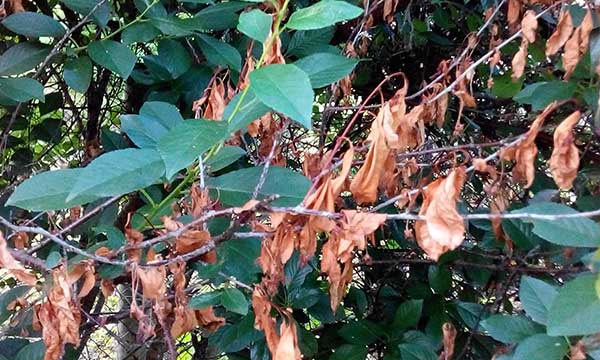
Content
What is stone fruit moniliosis: symptoms, causes,harmfulness
Moniliosis (monilial burn, gray fruit rot) is a dangerous and harmful fungal disease that can affect both stone fruit and pome fruit.
In this case, the disease manifests itself in 2 forms (by the nature of the manifestation):
- in the form of a burn of young leaves, inflorescences and ovaries (monilial burn);

Monilial burn brings the greatest harm to stone fruit crops (cherries, cherries, apricots, peaches, plums).
- and as fruit rot (monilial or gray fruit rot).
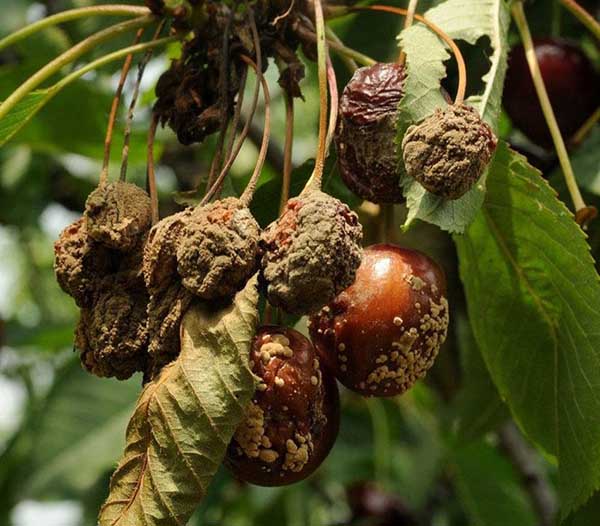
However! Fruit rot more often affects pome crops (apples, pears), but under favorable weather conditions for the development of the fungus, it can also occur on stone fruits.
By the way! Moniliosis of pome crops is dedicated to separate material.
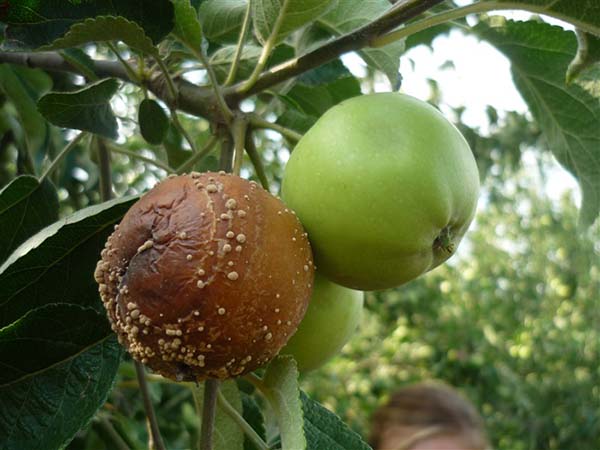
The causative agents of the disease are fungi of the genus Monilia (Monilia fructigena and Monilia cinerea), which overwinter in affected twigs and annual shoots, in mummified fruits hanging on a tree or fallen to the ground, plant debris (leaves).
The disease develops and manifests itself as follows (disease symptoms):
- Primary infection occurs during flowering (spring)... The spores of the fungus enter the ovary and pedicel, and then directly into the tissue of the shoots, causing them drying out (The first sign of the disease is the wilting of the ovaries, which turn brown as the disease progresses, but do not fall off. Further, young fruiting branches are affected, which also "burn" together with the leaves, after which the infection spreads to perennial skeletal branches).
Important! Do not confuse monilial burn with fire blight. In this case, the leaves do not just dry out, but rather sharply turn black.
- At the same time, the active development and spread of the disease is facilitated by: cool and wet weather, fog and dew during flowering.
Also contributes to infection thickening of plantings and / or poor ventilation of tree crowns.
- Already in the summer they are amazed and fruit... A characteristic sign of infection is the appearance on their rotting surface of small gray "pads" (sporulation of the fungus).
- Infection usually occurs through damage to the skin of the fruit, and strong distribution - when they come into contact with healthy ones.
It is the bites of insect pests that very often contribute to the infection of fruits with fruit rot, therefore do not forget to carry out timely insecticide spraying (with drugs for pests).
- Struck by monilial rot the fruits dry up (mummify) and fall off. Either stay hanging from a tree, in total, becoming a wintering place for the fungus and, accordingly, a source of future infection (next spring).
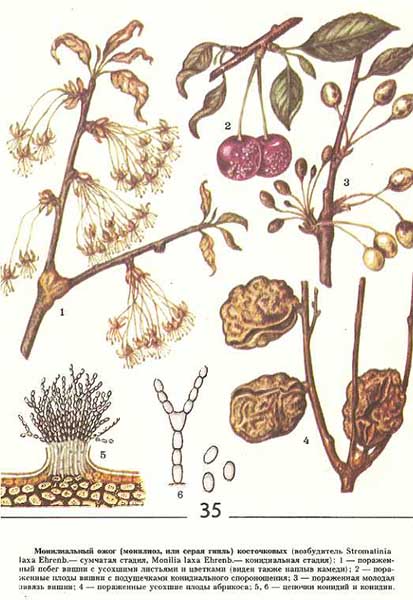
In this way, a significant part of the crop is lost... And if a tree is severely affected annually by moniliosis and a large number of branches dry out, the entire tree (at least part of its branches) may die.
Agrotechnical measures for the prevention and protection of stone fruit crops frommoniliosis
Here's What You Can Do To Reduce Potential Damage From Moniliosis
- Purchase only disease resistant stone fruit varieties.
- Plant seedlings at a sufficient distance from each other, while the place itself should be well-ventilated (not a stagnant lowland).
- Monitor the thickening of the trees themselves, regularlythin out the crown and spend anti-aging pruning old trees, because they are most susceptible to disease.
- In a timely manner cut and burn affected and dead branches (usually annuals). In this case, pruning should be carried out below the damage site, capturing part of a healthy branch (several healthy buds / leaves, about 10 cm), because the fungus moves down from the site of infection.
By the way! You can try to remove only individual affected inflorescences.
- Every autumn is a must collect affected mummified fruits and fallen leaves, and then burn (or take out from the site).
When and how to treat stone fruit trees from monilial burn
How to spray correctly
For the processing to be truly effective, certain rules must be followed:
- Spraying to carry out in the morning (after dew has dried) or in the evening (after sunset) or in the afternoon in cloudy weather.
- In this case, only in dry and calm weather.
- All prepared solutions cost pass through a filter meshso as not to clog the sprayer.
- Facilities for processing it is desirable change periodically (alternate, use alternately) so that there is no addiction (resistance).
It is important that the active ingredient was changed, and not just the name of the drug.
- If after processingcontact (copper-containing) drug it started raining immediately, then the next day spraying should be repeated. It's another matter if you usesystemic drug (Horus or Topsin-M), which penetrates into the plant and is not washed off with water.
- Chemical fungicides always havewaiting period (how long after spraying the fruits can be eaten), and this must be taken into account.
Important! Always read the instructions for use carefully before using any drug.
Terms and scheme of treatments
As a rule, preventive spraying against moniliosis is carried out at the following stages of tree development:
Before the start of sap flow, when the trees are still bare (the buds are still sleeping), spend early spring eradication treatment.
- During the period of swelling of the kidneys (phase of the "green cone") - copper-containing preparations (copper sulfate, Bordeaux liquid, Abiga-Peak, Hom).
- During the budding period (the “pink bud” phase), the treatment with copper-containing preparations is repeated or the use of Horus and other systemic fungicides is used.
- After flowering - again Horus or Topsin-M.
- Spraying is repeated 2-3 weeks after the previous treatment (but not less than 2-3 weeks before harvesting).
Note! Unfortunately, there is no point in spraying fruits that begin to rot (during their ripening period): they can no longer be cured. It is only necessary take them off and destroyso that the disease does not spread to healthy people.
- At the end of the season (with the beginning of leaf fall) autumn eradicating garden treatment.
Preparations for processing
The following chemical fungicidal agents are used to protect stone fruit crops from moniliosis:
Contact copper-containing fungicides (based on copper sulfate and copper oxychloride):
- Copper sulfate (protective contact fungicide based on copper sulfate);
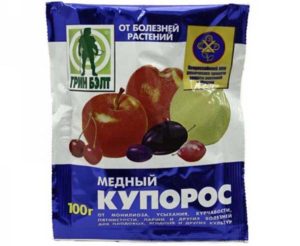
- Bordeaux liquid (contact fungicide of protective action based on copper sulfate and calcium hydroxide (lime);
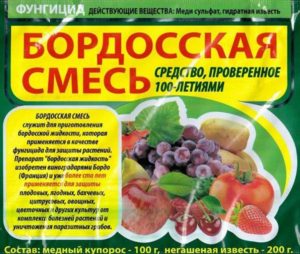
- Abiga-Peak (contact fungicide of protective action based on copper oxychloride);
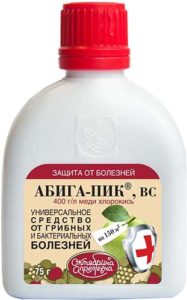
- Hom (contact fungicide of protective action based on copper oxychloride);
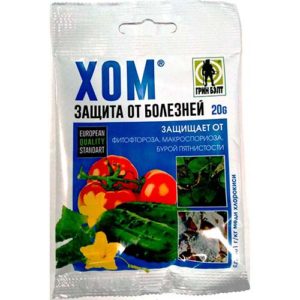
- Oxyhom (contact systemic fungicide protective actions based oncopper oxychloride and oxadixyl);
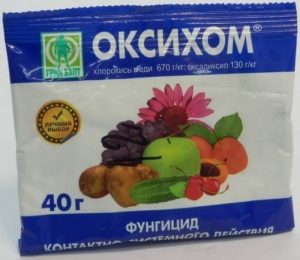
By the way! Copper treatment also helps combat coccomycosis of cherries and cherries, curly peach leaves and klyasternosporiosis (leaf perforation) of apricot, peach and cherry.
Systemic fungicides:
- Horus - (systemic fungicide of protective and curative action based cyprodinil);
From monilial burn - spraying is carried out before flowering, with an interval between treatments of 7-10 days (i.e. only 2 treatments before flowering).
From fruit rot - the first spraying is carried out when the first signs of the disease appear, the second - 14 days before harvesting.
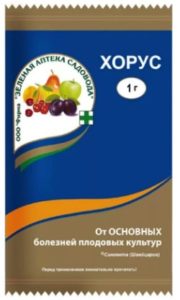
- Topsin-M (systemic contact protective fungicide actions based onThiophanate-methyl).
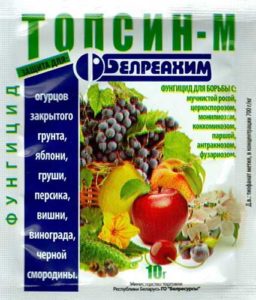
Interesting! To protect apple trees from moniliosis, you can use biological agents:
- Fitosporin (Bacillus subtilis strain 26 D);
- Fitolavin (Complex of streptotricin antibiotics and Phytobacteriomycin);
- Rizoplan (Pseudomonas fluorescens strain AP-33);
- Sporobacterin (Bacillus subtilis and Trichoderma viride, strain 4097);
- Alirin-B (Bacillus subtilis strain B-10 VIZR).
However! The instructions for these biologics say only about apple trees... But you can try.
Well, now you know when and how to spray stone fruit trees so that they are not struck by moniliosis (monilial burn, and subsequently fruit rot). Good luck!
Video: moniliosis - what kind of disease, how to resist (what preventive measures need to be taken) and what to treat


Good day! This year, through the sleeping buds, I treated the whole garden with copper sulfate, 1% of Bordeaux on the green cone, during the evening flowering Horus, it rained, after about 4 days of rains I found that the cherry was very badly beaten by moniliosis, to a lesser extent apricot. I cut off some dried fruit twigs, the tree stood with clean foliage. Now the fruits have begun to ripen and the apricots are rotting, in general the apricot tree looks healthy. Apricots need a few more days to fully ripen, but I see more rot every day. I noticed cracking on some of the tips of the apricots, and in these places insects begin to gnaw and rot also appears. It has not rained for a long time, he himself also did not water it during ripening. Fruit with a chicken egg. It was probably necessary to repeat the apricots with copper-containing ones ???? Who will give some advice? Trees are pruned every spring, not neglected, there are no weeds nearby, the ventilation is sufficient.
Good afternoon!
Copper fungicides are used only before flowering (the last time in the bud swelling phase). And 2-3 weeks before full ripening, any processing is completely stopped.
What to do ... perhaps all that remains for you is to spend autumn eradication treatment, and next spring, in addition to 3 sprays before flowering, also carry out the treatment immediately after flowering (on small ovaries) and repeat after 2 weeks.